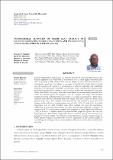Antimicrobial activities of crude leaf extract of Solanum Nigrumon Fusarium Oxysporum and Pseudomonas Syringae cultures in Maseno (Kenya)

View/
Publication Date
2017Author
Opande, GT
Musyimi, DM
Cherono, KL
Jiveri, BK
Buyela, DK
Metadata
Show full item recordAbstract/
Solanum nigrum (black nightshade) is a common short lived perennial plant found in the Kenyan highlands and worldwide in distribution. It is a small highly branched plant that rarely adopt a habit of more than a foot in height. In more than 60 countries, it is considered a weed yet it is utilized as an important medicinal or food plant in barely over 30 countries. In Kenya it is consumed as a delicious vegetable and traditional medicine with therapeutic potentials in anti-ulcer, cancer among other diseases. Such medicinal potentials have created a need to better understand anti-microbial activities of this plant. Before this study, little was known about the antimicrobial potentials of its crude leaf extract against
F. oxysporum and P. syringae, this study was therefore initiated to better understand these properties in varying concentrations. Plant leaves collected from Maseno University farm were shade dried and crushed to obtain a fine powder from where leaf extracts were obtained by cold method of extraction with ethanol as the solvent, at concentration ratio of 10%, 7.5%, 5%, and 2.5%. A control experiment was set with distilled water. Disc method was used for inoculation, replication of each leaf concentration was done and the data subjected to analysis of variance (ANOVA) and means separated and compared at Least Significant Difference (LSD) at P<0.05. S. nigrum extract has antimicrobial properties against the two test microorganisms. Flavanoids, terpenoids, tannin, saponin, phenol and steroid were detected in the leaf extract. The extracts showed that there is need to conduct studies in future studies leading to identification of active ingredients in this extract capable of controlling microbial growth and concentration of the extract does affect antimicrobial activities.
Collections
- Department of Botany [232]
